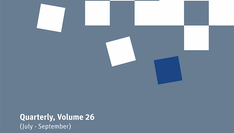Abstrakt
Predicting favourable products is still challenging. It is influenced by dynamic customers' requirement changes and reduction of waste. An important problem is a simultaneous combination of customer satisfaction with environmental aspects. It resulted from a need to reduce the harmfulness of products and increasing the quality level of these products. Therefore, the aim is to propose a method to predict favourable products considering qualitative and environmental aspects. The method relies on predicting which product will be the most favourable for customer, and simultaneously will be the most environmentally friendly. Due to the uncertainty of decisions, the Grey Relational Analysis (GRA) was implemented in the proposed method. The GRA method is effective to any number of data, therefore the proposed method does not have limitations in numbers of qualitative and environmental criteria. The test was carried out based on harmful industrial products. It was fluorescent penetrants used in popular non-destructive testing.
Bibliografia
Ertugrul, I. et al. (2016). Grey Relational Analysis Approach in Academic Performance Comparison of University: A Case Study Of Turkish Universities. “European Scientific Journal”, 12.
Hajduk-Stelmachowicz, M. (2017). Organisational Eco-innovations in the Companies Located in the Podkarpackie Province – The Aspect of Costs. “Reseach Papers of Wroclaw University of Economics”, 491.
Javed, S.A. et al. (2019). Systems Evaluation through New Grey Relational Analysis Approach: An Application on Thermal Conductivity – Petrophysical Parameters’ Relationships. “Processes”, 7. DOI: 10.3390/pr7060348.
Jiao, JX., Chen, CH. (2006). Customer requirement management in product development: A review of research issues. “Concurrent Engineering-Research And Applications”, 14(3). DOI: 10.1177/1063293X06068357.
Lawlor, K. B., Hornyak, M. J. (2012). Smart Goals: How The Application Of Smart Goals Can Contribute To Achievement Of Student Learning Outcomes. ”Developments in Business Simulation and Experiential Learning” 39.
Lee, C. H., Chen, C. H., Lin, C. Y., Li, F., Zhao, X. J. (2019). Developing a Quick Response Product Configuration System under Industry 4.0 Based on Customer Requirement Modelling and Optimization Method. “Applied Sciences-Basel”, 9(23). DOI: 10.3390/app9235004.
Luca, L. (2016). A new model of Ishikawa diagram for quality assessment, “IOP Conference Series Materials Science and Engineering”, 151, 1. DOI: 10.1088/1757-899X/161/1/012099.
Mentel, U., Hajduk-Stelmachowicz, M. (2020). Does standardization have an impact on innovation activity in different countries?. “Problems and Perspectives in Management”, 18(4). DOI: 10.21511/ppm.18(4).2020.39.
Mu, E., Pereyra-Rojas, M. (2017). Practical Decision Making [In:] Springer Briefs in Operations Research, Appendix A: Practical Questions Related to AHP Modeling; Springer Nature: Basel, Switzerland, 105–106.
Okrah, J., Hajduk-Stelmachowicz, M. (2020). Political stability and innovation in Africa. “Journal of International Studies”, 11. DOI: 10.14254/2071-8330.2020/13-1/15.
Pacana, A., Siwiec, D., Bednárová, L. (2020). Method of Choice: A Fluorescent Penetrant Taking into Account Sustainability Crite-ria. “Sustainability” 12, 5854. DOI: 10.3390/su12145854.
Rossiter, J., Lilien, G. (1994). New “Brainstorming” Principles. “Australian Journal of Management”, 19, 1.
Shi, Y. L., Peng, Q. J. (2020). A spectral clustering method to improve importance rating accuracy of customer requirements in QFD. “International Journal Of Advanced Manufacturing Technology”, 107(5–6). DOI: 10.1007/s00170-020-05204-1.
Siwiec D., Pacana A. (2021). Method of improve the level of product quality. “Production Engineering Archives”, 27(1). DOI: 10.30657/pea.2021.27.1.
Siwiec, D., Bednarova, L., Pacana, A. (2020). Metoda doboru penetrantów dla przemysłowych badań nieniszczących. „Przemysł Chemiczny”, 99(5). DOI: 10.15199/62.2020.5.18.
Siwiec, D., Bednarova, L., Pacana, A., Zawada, M., Rusko, M. (2019). Wspomaganie decyzji w procesie doboru penetrantów fluorescencyjnych do przemysłowych badań nieniszczących. „Przemysł Chemiczny”, 98(10). DOI: 10.15199/62.2019.10.12.
Siwiec, D., Pacana, A. (2021). A Pro-Environmental Method of Sample Size Determination to Predict the Quality Level of Products Considering Current Customers’ Expectations. “Sustainability” 13. DOI: 10.3390/su13105542.
Ulewicz, R., Kleszcz, D., Ulewicz, M. (2021). Implementation of Lean Instruments in Ceramics Industries. “Management Systems in Production Engineering”, 29(3). DOI: 10.2478/mspe-2021-0025.
Ulewicz, R., Siwiec, D., Pacana, A., Tutak, M., Brodny, J. (2021). Multi-Criteria Method for the Selection of Renewable Energy Sources in the Polish Industrial Sector. “Energies” 14. DOI: 10.3390/en14092386.
Wang F. et al. (2015). Capturing the key customer requirements for complex equipment design using Grey Relational Analysis. “Journal of Grey System”, 27(3).
Wszystkie teksty zamieszczone w kwartalniku "Modern Management Review", dostępne są w pełnej wersji na stronie internetowej Czasopisma. Od numeru 19 (3/2012) zostały także wprowadzone identyfikatory cyfrowe (DOI: 10.7862/rz.2018.mmr.1)
Artykuły w czasopiśmie Modern Management Review są udostępniane na warunkach licencji Creative Commons (CC-BY 4.0), w tym na następujących polach eksploatacji obejmujących:
- prawo do wydawania Utworu drukiem w formie książkowej i cyfrowej oraz jego rozpowszechniania w formie książkowej i cyfrowej, w tym poprzez wyświetlanie, odtworzenie, nadawanie, publiczne udostępnienie przez Wydawcę oraz podmioty trzecie,
- prawo do utrwalenia i zwielokrotnienia całości lub części Utworu na papierze i w formie zapisu cyfrowego oraz w każdy inny możliwy sposób przez Wydawcę,
- prawo do wprowadzania Utworu do pamięci komputera oraz zapisywania Utworu w systemach informatycznych Wydawcy i innych podmiotów dystrybuujących treści cyfrowe,
- prawo do archiwizowania Utworu oraz tworzenia kopii Utworu na nośnikach elektronicznych przez Wydawcę, bez ograniczeń ilościowych,
- prawo do digitalizacji Utworu oraz dokonywania konwersji/przekształceń Utworu w wersji elektronicznej na inne formaty cyfrowe przez Wydawcę oraz podmioty trzecie,
- prawo do rozpowszechniania Utworu, w tym za pośrednictwem sieci Internet lub innych sieci teleinformatycznych przez Wydawcę oraz inne podmioty trzecie, w sposób umożliwiający oglądanie, czytanie, kopiowanie treści Utworu w postaci elektronicznej, tj. wszystkich elementów do niego należących, przy czym przez kopiowanie rozumie się zapisanie przez osobę zainteresowaną udostępnionego jej Utworu na wybranym przez nią nośniku,
- prawo do przechowywania Utworu w bazie danych Wydawcy i innych podmiotów dystrybuujących Utwór w jakiejkolwiek postaci, jak również jego przetwarzania w bazie danych Wydawcy oraz podmiotów trzecich,
- prawo do tłumaczenia i wydania Utworu w jednym z języków nowożytnych w jakiejkolwiek postaci przez Wydawcę oraz podmioty trzecie.


